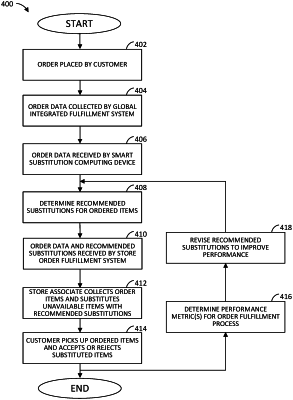| CPC G06Q 30/0629 (2013.01) [G06Q 30/0201 (2013.01); G06Q 30/0635 (2013.01); G06Q 30/0641 (2013.01)] | 17 Claims |

|
1. A system comprising:
a communications interface configured to communicate, over one or more networks, with a computing device associated with each of a plurality of customers of an e-commerce platform, and a plurality of computing systems associated with a plurality of stores, each of the plurality of computing systems including one or more other computing devices;
a non-transitory memory resource storing instructions;
a database storing item attribute data and customer attribute data; and
one or more processors coupled to the communications interface and the memory resource, the one or more processors being configured to execute the instructions to:
train a customer understanding model to generate a preference score for each substitution item of a plurality of substitution items, the preference score indicating a likelihood that one of the plurality of substitution items will be accepted as a replacement for an anchor item, wherein the customer understanding model is trained by an iterative training process using a training dataset including customer purchase behavior over a first predetermined time period and a second predetermined time period;
receive, over the one or more networks via the communications interface and from a computing device of a first customer of the plurality of customers, order data, the order data including data indicative of at least one item ordered by the first customer and location data indicating a location of a particular store of the plurality of stores;
obtain, from the database, item attribute data associated with the at least one item, the item attribute data corresponding to a characteristic of the at least one item and a common characteristic of a plurality of related substitution items;
obtain, from the database, customer attribute data identifying preferences of the first customer;
a substitution identification engine communicatively coupled to the non-transitory memory and the database, the substitution identification engine configured to:
during a first time interval, implement the customer understanding model to generate a customer preference score for each related substitution item of the plurality of related substitution items, wherein the customer understanding model is configured to execute a set of operations including:
generating the customer preference score for each substitution item in the plurality of substitution items based on the item attribute data and the customer attribute data; and
ranking each substitution item in the plurality of substitution items based on the preference scores;
obtain item title data that corresponds to characteristics of the plurality of related substitution items;
generate a relevance score for each related substitution item in the plurality of related substitution items based on the item title data, the relevance score indicating a relevancy between the at least one item ordered by the first customer and the related substitution item; and
generate an overall substitution score by combining the relevance score and the preference score;
transmit, over the one or more networks and to a computing device associated with the particular store, the order data along with substitution data that includes information identifying each related substitution item in the plurality of related substitution items and corresponding rank; and
a process comparison engine communicatively coupled to the communications interface and the non-transitory memory, wherein the process comparison engine is configured to:
obtain, via the communications interface over the one or more networks and from the computing device associated with the particular store, first performance data associated with the set of operations, the order data, the substitution data, and the particular store, the first performance data indicating at least a performance of the system implementing the set of operations during the first time interval; and
based on performance data obtained from the computing device associated with the particular store, determine, for the particular store, one or more performance metrics associated with the system,
wherein the processor is further configured to execute instructions to:
receive the one or more performance metrics; and
train an updated customer understanding model to generate an updated preference score for each substitution item of the plurality of substitution items, the updated preference score indicating an updated likelihood that one of the plurality of substitution items will be accepted as a replacement for an anchor item, wherein updated customer understanding model is trained by an iterative training process using an updated training dataset including the one or more performance metrics associated with the first customer,
wherein the substitution identification engine is configured to:
during a second time interval, implement updated the customer understanding model to generate the updated preference score for one or more related substitution items of the plurality of related substitution items; and
wherein the processor is further configured to modify the updated customer understanding model based on the updated training dataset and updated performance metrics generated from second performance data associated with implementation of the updated customer understanding model.
|